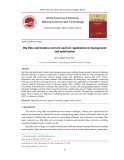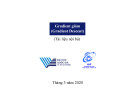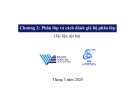
Vu Minh Tuan, Do Thuy Duong, Tran Quang Anh
EVALUATION OF WORD EMBEDDING
TECHNIQUES FOR THE VIETNAMESE
SMS SPAM DETECTION MODEL
Vu Minh Tuan*, Do Thuy Duong*, Tran Quang Anh+
*Hanoi University
+ Posts and Telecommunications Institute of Technology
Abstract: The escalating issue of SMS spam in
Vietnamese text messages has prompted the adoption of
machine learning and deep learning models for effective
detection. This paper investigates the impact of word
embedding techniques on enhancing SMS spam detection
models. Traditional statistical methods (BoW, TF-IDF) are
compared with advanced techniques (Word2Vec, fastText,
GloVe, PhoBERT) using a proprietary dataset. The
evaluation focuses on accuracy, precision, recall, and F1
Score. PhoBERT integrated with CNN model showcased
the highest accuracy of 0.968 and a remarkable F1 score of
0.941. The study sheds light on the role of word
embeddings in constructing robust spam detection models,
offering valuable guidance for model selection. The
methodology, comparative analysis, and future directions
are also presented in the paper.
Keywords: Vietnamese SMS spam, word embedding,
deep learning, CNN.
I. INTRODUCTION
In recent years, the proliferation of mobile devices and
the widespread use of short message service (SMS) have led
to an increase in SMS spam, posing a significant challenge
for effective spam detection in Vietnamese text messages.
To combat this issue, machine learning and deep learning
models have been widely adopted for SMS spam detection,
where the quality of word representation plays a crucial role
in the model's performance.
Word embedding techniques have emerged as powerful
tools for capturing the semantic meaning and contextual
information of words in natural language processing tasks.
In the context of SMS spam detection, word embeddings
can be particularly beneficial in transforming raw text
messages into meaningful numerical representations,
enhancing the performance of models.
In this paper, Naïve Bayes (NB) and Convolutional
Neural Network (CNN) were deployed as representatives of
traditional machine learning and deep learning models to
detect Vietnamese SMS spams. This study aims to explore
and evaluate various word embedding techniques for
developing an efficient SMS spam detection model for
Vietnamese text. The performance of traditional statistical
word embedding methods such as Bag-of-Words (BoW)
and Term Frequency-Inverse Document Frequency (TF-
IDF) against more advanced techniques such as Word2Vec,
fastText, GloVe and PhoBERT will be assessed. The
evaluation will be conducted using a private dataset of
annotated SMS messages, comprising both spam and non-
spam messages, with specific attention to accuracy,
precision, recall, and F1 Score. The combined utilization of
PhoBERT and the CNN model demonstrated the utmost
accuracy value of 0.968, accompanied by a notable F1 score
reaching 0.941. By shedding light on the significance of
word embedding techniques in the context of Vietnamese
SMS spam detection, the research provides insights into
choosing appropriate word representations for building
robust and accurate spam detection models.
The rest of the paper is structured as follows. The related
works are reviewed in Section II. All about the
methodology including data collection and pre-processing,
word embedding techniques is presented in Section III.
Section IV compares and discusses the results of the
research. Section V includes conclusion and future works.
II. RELATED WORKS
Word representation techniques played an important
role in the achievement of the spam detection models. These
techniques were compared or evaluated as a factor of
success in studies mentioned below.
Gauri Jain et al. [1] proposed using a convolutional
neural network (CNN) with a semantic layer on top,
creating a semantic convolutional neural network (SCNN).
The semantic layer enriched word embeddings using
Word2Vec for training random word vectors and WordNet
and ConceptNet to find similar words when word2vec is
unavailable. The SCNN architecture was evaluated on two
corpora: SMS Spam dataset (UCI repository) and Twitter
dataset. The approach achieved impressive results,
outperforming the state-of-the-art with 98.65% accuracy on
the SMS spam dataset and 94.40% accuracy on the Twitter
dataset.
Sreekanth and Maunendra [2] presented several deep
learning models based on convolutional neural networks
(CNNs). In total, five CNNs, each employing different
word embeddings (GloVe, Word2Vec), and one feature-
based model were utilized in the ensemble. The feature-
based model incorporates content-based, user-based, and n-
gram features. The proposed approach is evaluated on two
Contact author: Vu Minh Tuan
Email: minhtuan_fit@hanu.edu.vn
Manuscript received: 8/2023, revised: 9/2023, accepted:
9/2023.
No. 03 (CS.01) 2023
JOURNAL OF SCIENCE AND TECHNOLOGY ON INFORMATION AND COMMUNICATIONS 12






























